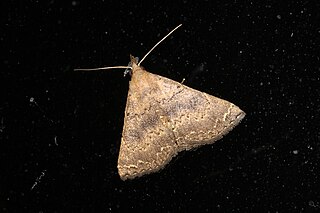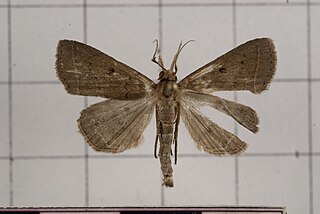
Sufetula is a genus of moths of the family Crambidae.
Labanda is a genus of moths of the family Nolidae erected by Francis Walker in 1859.
Dunira is a genus of moths of the family Erebidae. The genus was erected by Frederic Moore in 1885.

Hadennia is a genus of moths of the family Erebidae. The genus was erected by Frederic Moore in 1885.

Lysimelia is a genus of moths of the family Noctuidae. The genus was erected by Francis Walker in 1859.

Oglasa is a genus of moths in the family Erebidae. The genus was erected by Francis Walker in 1859.
Encrasima is a genus of moths in the family Autostichidae.
Brana is a monotypic moth genus of the family Noctuidae. Its only species, Brana calopasa, is found in Sri Lanka and Australia. Both the genus and species were described by Francis Walker, the genus in 1858 and the species in 1859. It It is a serious pest on Berrya cordifolia.
Chusaris retatalis is a moth of the family Noctuidae first described by Francis Walker in 1859. It is found in Sri Lanka.
Noreia ajaia is a moth of the family Geometridae first described by Francis Walker in 1859. Its geographical range includes areas from the Oriental regions of India and Sri Lanka to Singapore and Sundaland.
Hadennia jutalis is a moth of the family Noctuidae first described by Francis Walker in 1859. It is found in India, Sri Lanka, Thailand, Malaysia, Laos, Vietnam, Myanmar and the Andaman Islands.
Hadennia mysalis is a moth of the family Noctuidae first described by Francis Walker in 1859. It is found in Sri Lanka, Japan, Taiwan, Thailand, Borneo, Myanmar and the Andaman Islands.

Hydrillodes abavalis is a moth of the family Erebidae first described by Francis Walker in 1859. It is found in Sri Lanka and Borneo.

Hydrillodes gravatalis is a moth of the family Erebidae first described by Francis Walker in 1859. It is found in the Indian subregion, Sri Lanka and Sundaland.

Progonia oileusalis is a species of moth in the family Noctuidae first described by Francis Walker in 1859. It is found in Sri Lanka, Borneo, India, Taiwan, Japan and the Philippines.

Simplicia butesalis is a moth of the family Erebidae first described by Francis Walker in 1859. It is found in Borneo, Sumatra, Peninsular Malaysia and Sri Lanka.
Corgatha zonalis is a moth of the family Erebidae first described by Francis Walker in 1859. It is found in Oriental tropics of India and from Sri Lanka to Borneo, the Philippines and Japan.
Hypena mandatalis, is a moth of the family Erebidae first described by Francis Walker in 1859. It is found in the Indian subregion, Pakistan, Sri Lanka, Borneo, Sulawesi and Australia.
Hypolamprus bastialis is a moth of the family Thyrididae first described by Francis Walker in 1859. It is found in India, Sri Lanka, Indonesia, New Guinea and Australia.
Labanda herbealis is a moth in the family Nolidae first described by Francis Walker in 1859. It is found in Sri Lanka and Borneo.







